Hotel Hazard Analysis Report: Health and Safety in Hotels
VerifiedAdded on 2020/09/30
|8
|1691
|312
Report
AI Summary
This Hotel Hazard Analysis Report meticulously examines various workplace hazards common in the hospitality industry, including overexertion, slippery floors, biohazards, violence, cuts, chemical exposures, and harassment. The report outlines the severity of each hazard, ranging from low to severe, and proposes detailed prevention strategies, such as administrative controls, personal protective equipment (PPE), and comprehensive worker training. It emphasizes the importance of a proactive safety plan, regular workplace inspections, and ongoing communication with staff. The report also delves into the Hierarchy of Controls, advocating for the elimination, substitution, engineering controls, administrative controls, and PPE to minimize risks. Furthermore, it underscores the significance of thorough worker training and effective supervision to ensure a safe and healthy work environment, concluding with a sample housekeeping department checklist to reinforce safety protocols. This report is designed to help hotels effectively manage risks and foster a culture of safety.
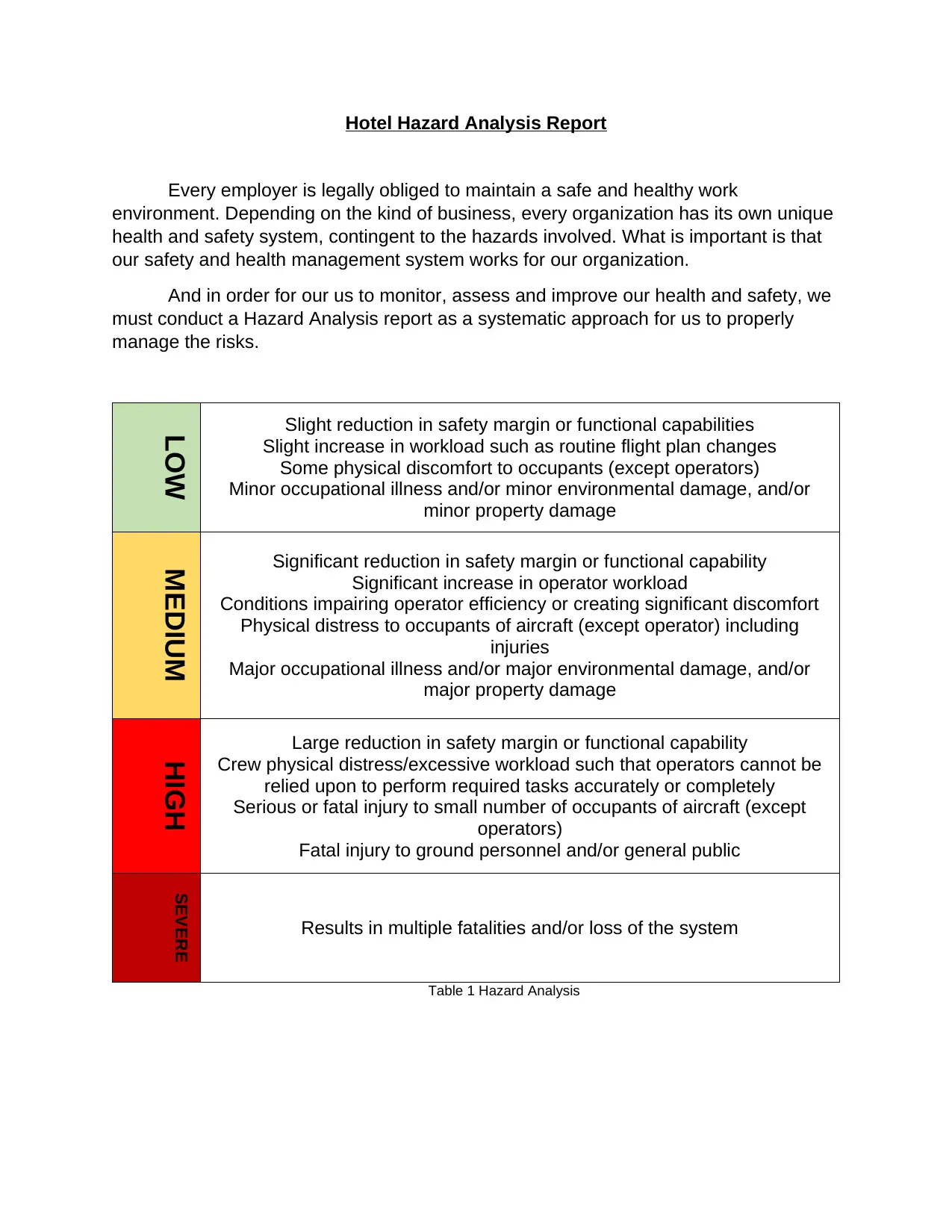
Hotel Hazard Analysis Report
Every employer is legally obliged to maintain a safe and healthy work
environment. Depending on the kind of business, every organization has its own unique
health and safety system, contingent to the hazards involved. What is important is that
our safety and health management system works for our organization.
And in order for our us to monitor, assess and improve our health and safety, we
must conduct a Hazard Analysis report as a systematic approach for us to properly
manage the risks.
LOW
Slight reduction in safety margin or functional capabilities
Slight increase in workload such as routine flight plan changes
Some physical discomfort to occupants (except operators)
Minor occupational illness and/or minor environmental damage, and/or
minor property damage
MEDIUM
Significant reduction in safety margin or functional capability
Significant increase in operator workload
Conditions impairing operator efficiency or creating significant discomfort
Physical distress to occupants of aircraft (except operator) including
injuries
Major occupational illness and/or major environmental damage, and/or
major property damage
HIGH
Large reduction in safety margin or functional capability
Crew physical distress/excessive workload such that operators cannot be
relied upon to perform required tasks accurately or completely
Serious or fatal injury to small number of occupants of aircraft (except
operators)
Fatal injury to ground personnel and/or general public
SEVERE
Results in multiple fatalities and/or loss of the system
Table 1 Hazard Analysis
Every employer is legally obliged to maintain a safe and healthy work
environment. Depending on the kind of business, every organization has its own unique
health and safety system, contingent to the hazards involved. What is important is that
our safety and health management system works for our organization.
And in order for our us to monitor, assess and improve our health and safety, we
must conduct a Hazard Analysis report as a systematic approach for us to properly
manage the risks.
LOW
Slight reduction in safety margin or functional capabilities
Slight increase in workload such as routine flight plan changes
Some physical discomfort to occupants (except operators)
Minor occupational illness and/or minor environmental damage, and/or
minor property damage
MEDIUM
Significant reduction in safety margin or functional capability
Significant increase in operator workload
Conditions impairing operator efficiency or creating significant discomfort
Physical distress to occupants of aircraft (except operator) including
injuries
Major occupational illness and/or major environmental damage, and/or
major property damage
HIGH
Large reduction in safety margin or functional capability
Crew physical distress/excessive workload such that operators cannot be
relied upon to perform required tasks accurately or completely
Serious or fatal injury to small number of occupants of aircraft (except
operators)
Fatal injury to ground personnel and/or general public
SEVERE
Results in multiple fatalities and/or loss of the system
Table 1 Hazard Analysis
Paraphrase This Document
Need a fresh take? Get an instant paraphrase of this document with our AI Paraphraser
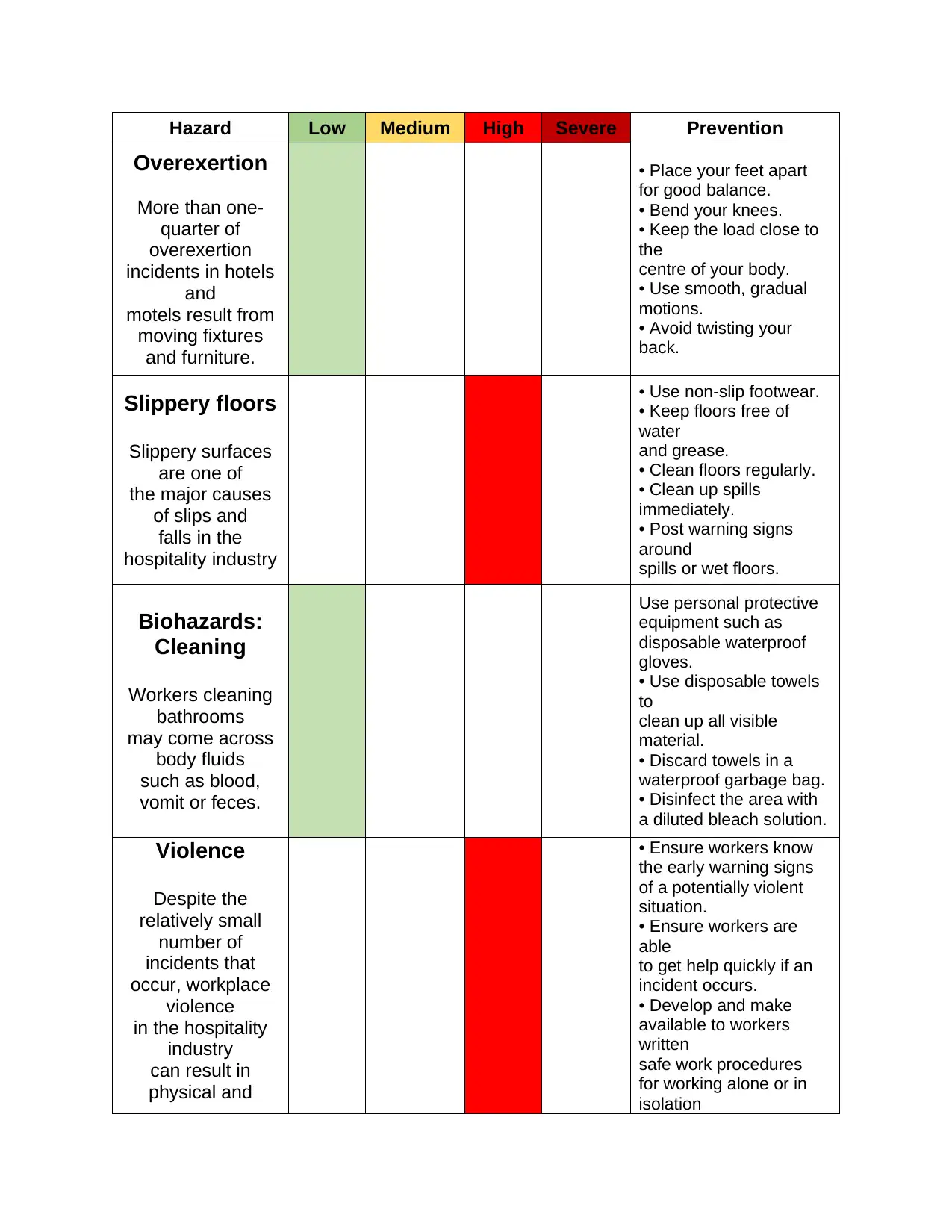
Hazard Low Medium High Severe Prevention
Overexertion
More than one-
quarter of
overexertion
incidents in hotels
and
motels result from
moving fixtures
and furniture.
• Place your feet apart
for good balance.
• Bend your knees.
• Keep the load close to
the
centre of your body.
• Use smooth, gradual
motions.
• Avoid twisting your
back.
Slippery floors
Slippery surfaces
are one of
the major causes
of slips and
falls in the
hospitality industry
• Use non-slip footwear.
• Keep floors free of
water
and grease.
• Clean floors regularly.
• Clean up spills
immediately.
• Post warning signs
around
spills or wet floors.
Biohazards:
Cleaning
Workers cleaning
bathrooms
may come across
body fluids
such as blood,
vomit or feces.
Use personal protective
equipment such as
disposable waterproof
gloves.
• Use disposable towels
to
clean up all visible
material.
• Discard towels in a
waterproof garbage bag.
• Disinfect the area with
a diluted bleach solution.
Violence
Despite the
relatively small
number of
incidents that
occur, workplace
violence
in the hospitality
industry
can result in
physical and
• Ensure workers know
the early warning signs
of a potentially violent
situation.
• Ensure workers are
able
to get help quickly if an
incident occurs.
• Develop and make
available to workers
written
safe work procedures
for working alone or in
isolation
Overexertion
More than one-
quarter of
overexertion
incidents in hotels
and
motels result from
moving fixtures
and furniture.
• Place your feet apart
for good balance.
• Bend your knees.
• Keep the load close to
the
centre of your body.
• Use smooth, gradual
motions.
• Avoid twisting your
back.
Slippery floors
Slippery surfaces
are one of
the major causes
of slips and
falls in the
hospitality industry
• Use non-slip footwear.
• Keep floors free of
water
and grease.
• Clean floors regularly.
• Clean up spills
immediately.
• Post warning signs
around
spills or wet floors.
Biohazards:
Cleaning
Workers cleaning
bathrooms
may come across
body fluids
such as blood,
vomit or feces.
Use personal protective
equipment such as
disposable waterproof
gloves.
• Use disposable towels
to
clean up all visible
material.
• Discard towels in a
waterproof garbage bag.
• Disinfect the area with
a diluted bleach solution.
Violence
Despite the
relatively small
number of
incidents that
occur, workplace
violence
in the hospitality
industry
can result in
physical and
• Ensure workers know
the early warning signs
of a potentially violent
situation.
• Ensure workers are
able
to get help quickly if an
incident occurs.
• Develop and make
available to workers
written
safe work procedures
for working alone or in
isolation
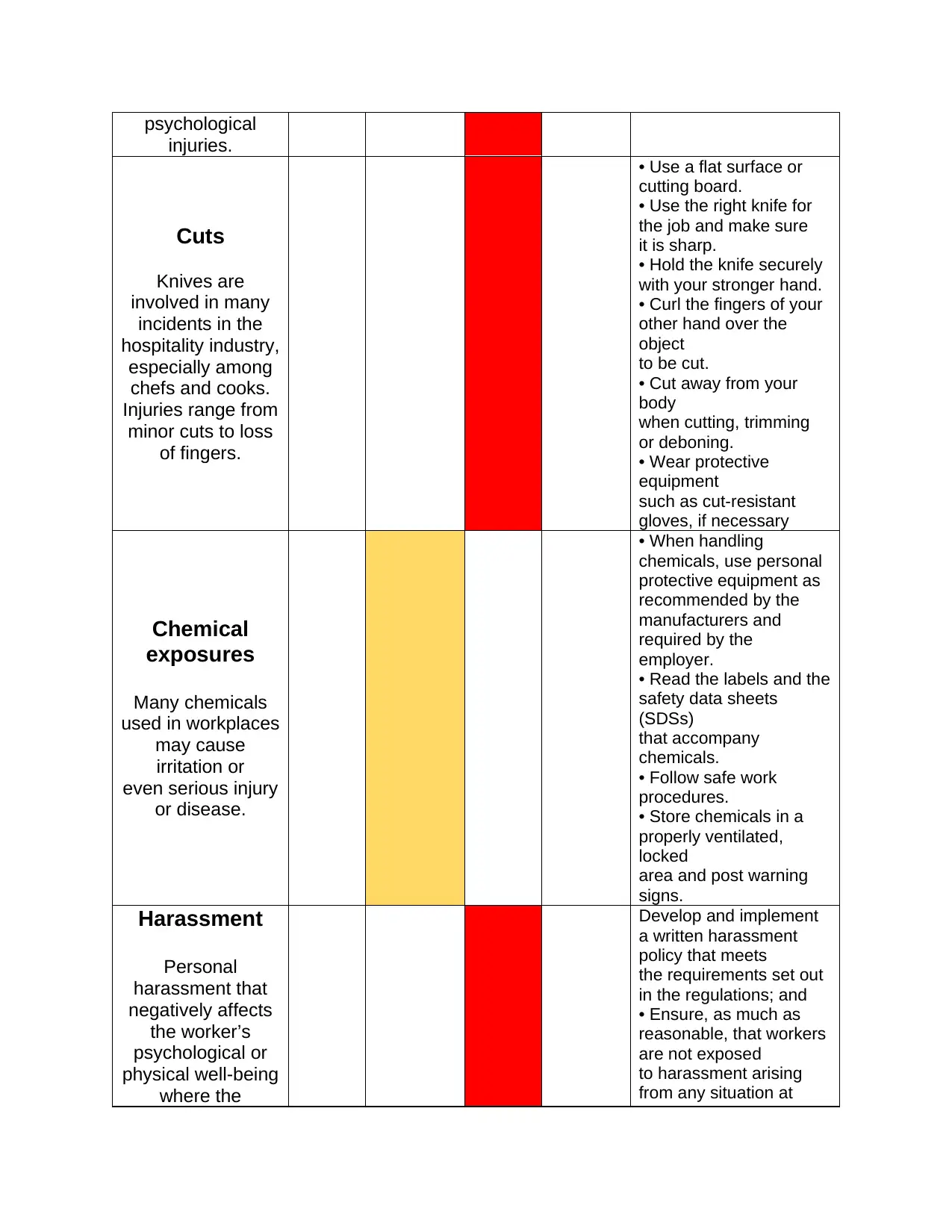
psychological
injuries.
Cuts
Knives are
involved in many
incidents in the
hospitality industry,
especially among
chefs and cooks.
Injuries range from
minor cuts to loss
of fingers.
• Use a flat surface or
cutting board.
• Use the right knife for
the job and make sure
it is sharp.
• Hold the knife securely
with your stronger hand.
• Curl the fingers of your
other hand over the
object
to be cut.
• Cut away from your
body
when cutting, trimming
or deboning.
• Wear protective
equipment
such as cut-resistant
gloves, if necessary
Chemical
exposures
Many chemicals
used in workplaces
may cause
irritation or
even serious injury
or disease.
• When handling
chemicals, use personal
protective equipment as
recommended by the
manufacturers and
required by the
employer.
• Read the labels and the
safety data sheets
(SDSs)
that accompany
chemicals.
• Follow safe work
procedures.
• Store chemicals in a
properly ventilated,
locked
area and post warning
signs.
Harassment
Personal
harassment that
negatively affects
the worker’s
psychological or
physical well-being
where the
Develop and implement
a written harassment
policy that meets
the requirements set out
in the regulations; and
• Ensure, as much as
reasonable, that workers
are not exposed
to harassment arising
from any situation at
injuries.
Cuts
Knives are
involved in many
incidents in the
hospitality industry,
especially among
chefs and cooks.
Injuries range from
minor cuts to loss
of fingers.
• Use a flat surface or
cutting board.
• Use the right knife for
the job and make sure
it is sharp.
• Hold the knife securely
with your stronger hand.
• Curl the fingers of your
other hand over the
object
to be cut.
• Cut away from your
body
when cutting, trimming
or deboning.
• Wear protective
equipment
such as cut-resistant
gloves, if necessary
Chemical
exposures
Many chemicals
used in workplaces
may cause
irritation or
even serious injury
or disease.
• When handling
chemicals, use personal
protective equipment as
recommended by the
manufacturers and
required by the
employer.
• Read the labels and the
safety data sheets
(SDSs)
that accompany
chemicals.
• Follow safe work
procedures.
• Store chemicals in a
properly ventilated,
locked
area and post warning
signs.
Harassment
Personal
harassment that
negatively affects
the worker’s
psychological or
physical well-being
where the
Develop and implement
a written harassment
policy that meets
the requirements set out
in the regulations; and
• Ensure, as much as
reasonable, that workers
are not exposed
to harassment arising
from any situation at
⊘ This is a preview!⊘
Do you want full access?
Subscribe today to unlock all pages.

Trusted by 1+ million students worldwide
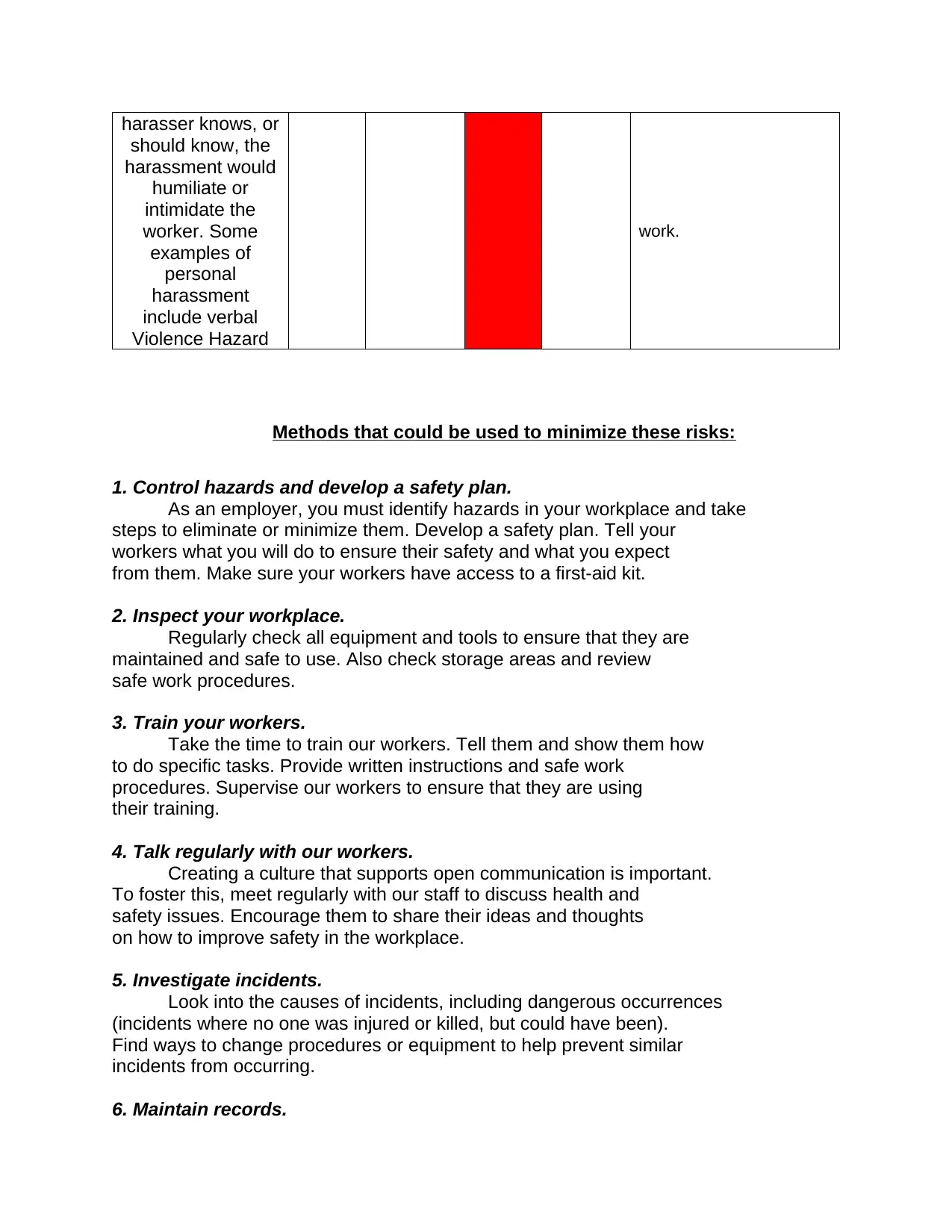
harasser knows, or
should know, the
harassment would
humiliate or
intimidate the
worker. Some
examples of
personal
harassment
include verbal
Violence Hazard
work.
Methods that could be used to minimize these risks:
1. Control hazards and develop a safety plan.
As an employer, you must identify hazards in your workplace and take
steps to eliminate or minimize them. Develop a safety plan. Tell your
workers what you will do to ensure their safety and what you expect
from them. Make sure your workers have access to a first-aid kit.
2. Inspect your workplace.
Regularly check all equipment and tools to ensure that they are
maintained and safe to use. Also check storage areas and review
safe work procedures.
3. Train your workers.
Take the time to train our workers. Tell them and show them how
to do specific tasks. Provide written instructions and safe work
procedures. Supervise our workers to ensure that they are using
their training.
4. Talk regularly with our workers.
Creating a culture that supports open communication is important.
To foster this, meet regularly with our staff to discuss health and
safety issues. Encourage them to share their ideas and thoughts
on how to improve safety in the workplace.
5. Investigate incidents.
Look into the causes of incidents, including dangerous occurrences
(incidents where no one was injured or killed, but could have been).
Find ways to change procedures or equipment to help prevent similar
incidents from occurring.
6. Maintain records.
should know, the
harassment would
humiliate or
intimidate the
worker. Some
examples of
personal
harassment
include verbal
Violence Hazard
work.
Methods that could be used to minimize these risks:
1. Control hazards and develop a safety plan.
As an employer, you must identify hazards in your workplace and take
steps to eliminate or minimize them. Develop a safety plan. Tell your
workers what you will do to ensure their safety and what you expect
from them. Make sure your workers have access to a first-aid kit.
2. Inspect your workplace.
Regularly check all equipment and tools to ensure that they are
maintained and safe to use. Also check storage areas and review
safe work procedures.
3. Train your workers.
Take the time to train our workers. Tell them and show them how
to do specific tasks. Provide written instructions and safe work
procedures. Supervise our workers to ensure that they are using
their training.
4. Talk regularly with our workers.
Creating a culture that supports open communication is important.
To foster this, meet regularly with our staff to discuss health and
safety issues. Encourage them to share their ideas and thoughts
on how to improve safety in the workplace.
5. Investigate incidents.
Look into the causes of incidents, including dangerous occurrences
(incidents where no one was injured or killed, but could have been).
Find ways to change procedures or equipment to help prevent similar
incidents from occurring.
6. Maintain records.
Paraphrase This Document
Need a fresh take? Get an instant paraphrase of this document with our AI Paraphraser
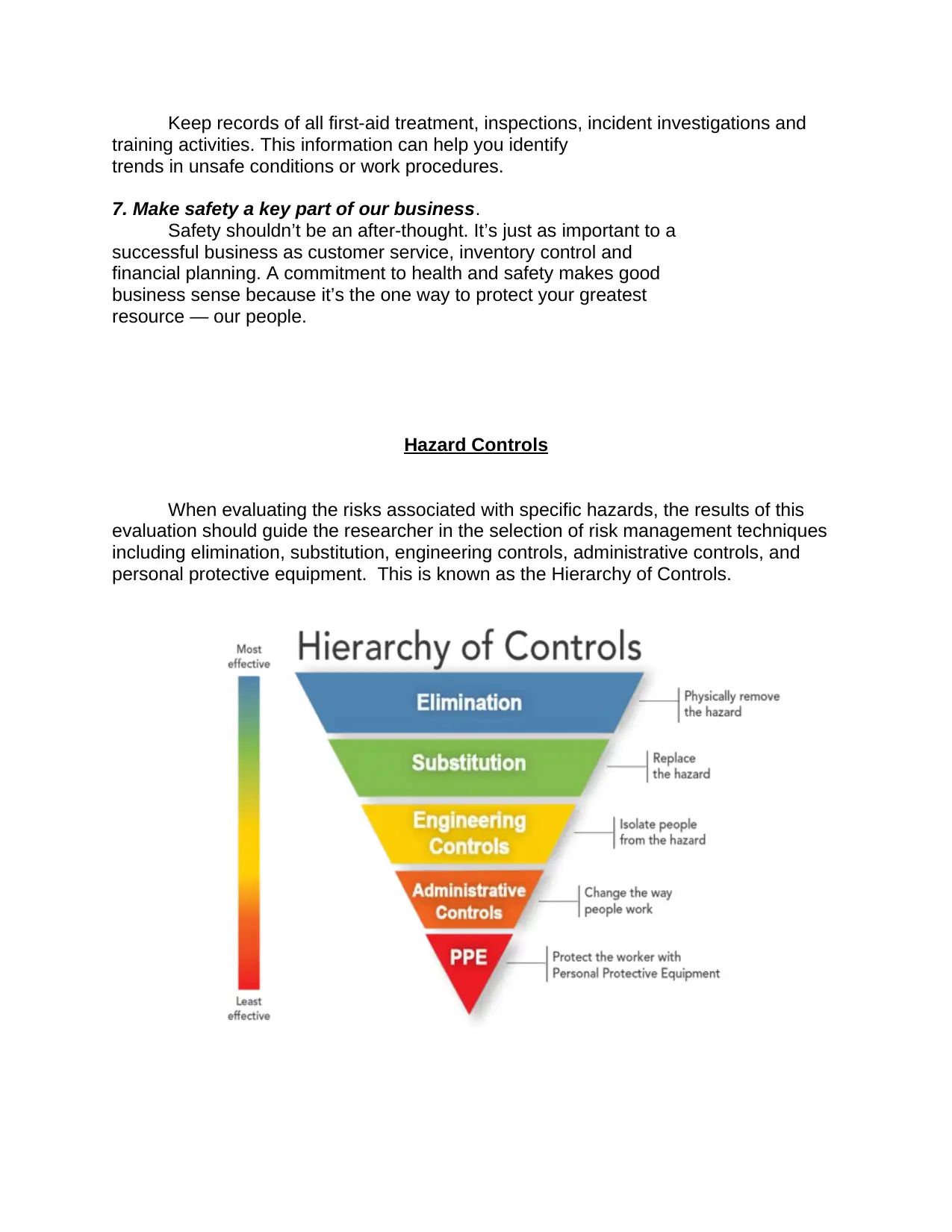
Keep records of all first-aid treatment, inspections, incident investigations and
training activities. This information can help you identify
trends in unsafe conditions or work procedures.
7. Make safety a key part of our business.
Safety shouldn’t be an after-thought. It’s just as important to a
successful business as customer service, inventory control and
financial planning. A commitment to health and safety makes good
business sense because it’s the one way to protect your greatest
resource — our people.
Hazard Controls
When evaluating the risks associated with specific hazards, the results of this
evaluation should guide the researcher in the selection of risk management techniques
including elimination, substitution, engineering controls, administrative controls, and
personal protective equipment. This is known as the Hierarchy of Controls.
training activities. This information can help you identify
trends in unsafe conditions or work procedures.
7. Make safety a key part of our business.
Safety shouldn’t be an after-thought. It’s just as important to a
successful business as customer service, inventory control and
financial planning. A commitment to health and safety makes good
business sense because it’s the one way to protect your greatest
resource — our people.
Hazard Controls
When evaluating the risks associated with specific hazards, the results of this
evaluation should guide the researcher in the selection of risk management techniques
including elimination, substitution, engineering controls, administrative controls, and
personal protective equipment. This is known as the Hierarchy of Controls.
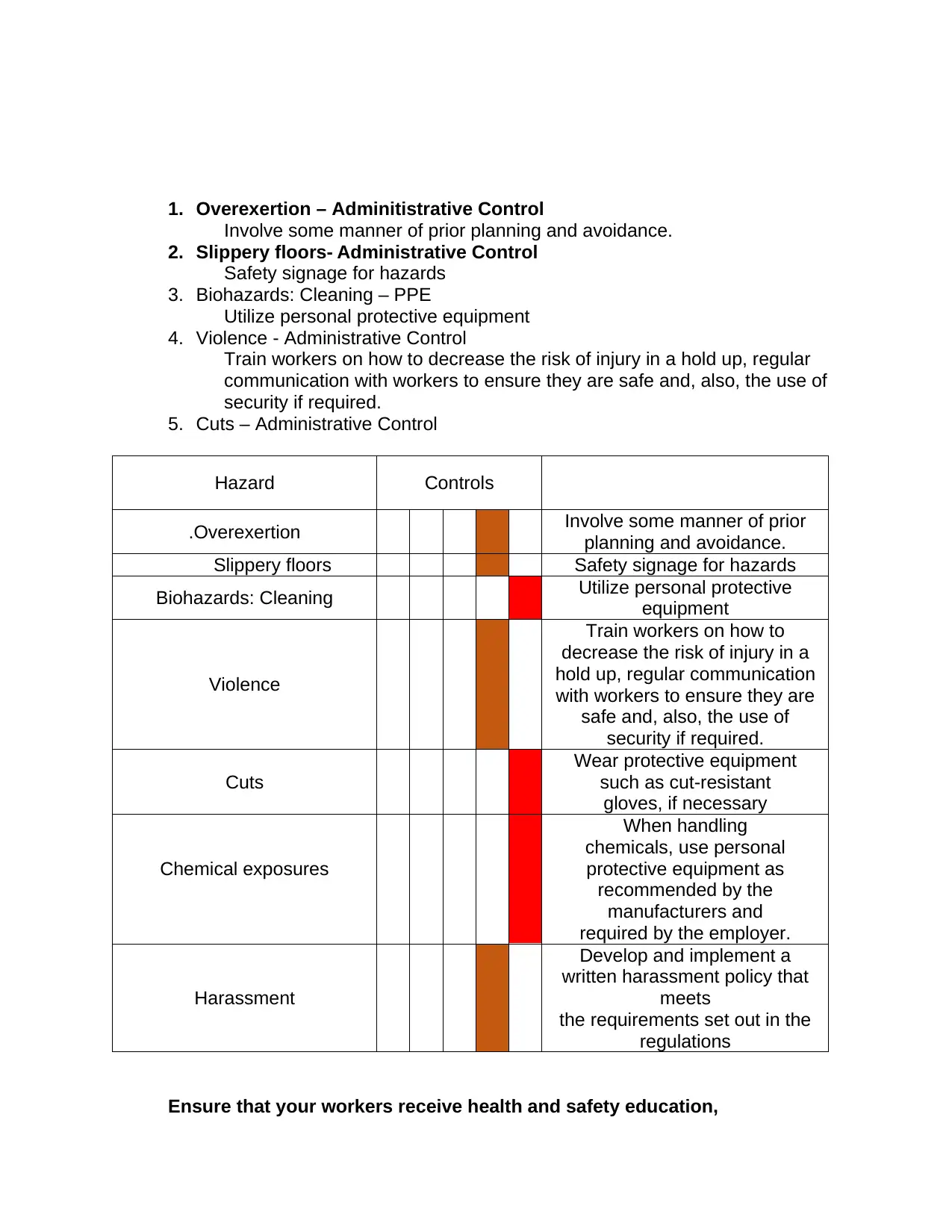
1. Overexertion – Adminitistrative Control
Involve some manner of prior planning and avoidance.
2. Slippery floors- Administrative Control
Safety signage for hazards
3. Biohazards: Cleaning – PPE
Utilize personal protective equipment
4. Violence - Administrative Control
Train workers on how to decrease the risk of injury in a hold up, regular
communication with workers to ensure they are safe and, also, the use of
security if required.
5. Cuts – Administrative Control
Hazard Controls
.Overexertion Involve some manner of prior
planning and avoidance.
Slippery floors Safety signage for hazards
Biohazards: Cleaning Utilize personal protective
equipment
Violence
Train workers on how to
decrease the risk of injury in a
hold up, regular communication
with workers to ensure they are
safe and, also, the use of
security if required.
Cuts
Wear protective equipment
such as cut-resistant
gloves, if necessary
Chemical exposures
When handling
chemicals, use personal
protective equipment as
recommended by the
manufacturers and
required by the employer.
Harassment
Develop and implement a
written harassment policy that
meets
the requirements set out in the
regulations
Ensure that your workers receive health and safety education,
Involve some manner of prior planning and avoidance.
2. Slippery floors- Administrative Control
Safety signage for hazards
3. Biohazards: Cleaning – PPE
Utilize personal protective equipment
4. Violence - Administrative Control
Train workers on how to decrease the risk of injury in a hold up, regular
communication with workers to ensure they are safe and, also, the use of
security if required.
5. Cuts – Administrative Control
Hazard Controls
.Overexertion Involve some manner of prior
planning and avoidance.
Slippery floors Safety signage for hazards
Biohazards: Cleaning Utilize personal protective
equipment
Violence
Train workers on how to
decrease the risk of injury in a
hold up, regular communication
with workers to ensure they are
safe and, also, the use of
security if required.
Cuts
Wear protective equipment
such as cut-resistant
gloves, if necessary
Chemical exposures
When handling
chemicals, use personal
protective equipment as
recommended by the
manufacturers and
required by the employer.
Harassment
Develop and implement a
written harassment policy that
meets
the requirements set out in the
regulations
Ensure that your workers receive health and safety education,
⊘ This is a preview!⊘
Do you want full access?
Subscribe today to unlock all pages.

Trusted by 1+ million students worldwide
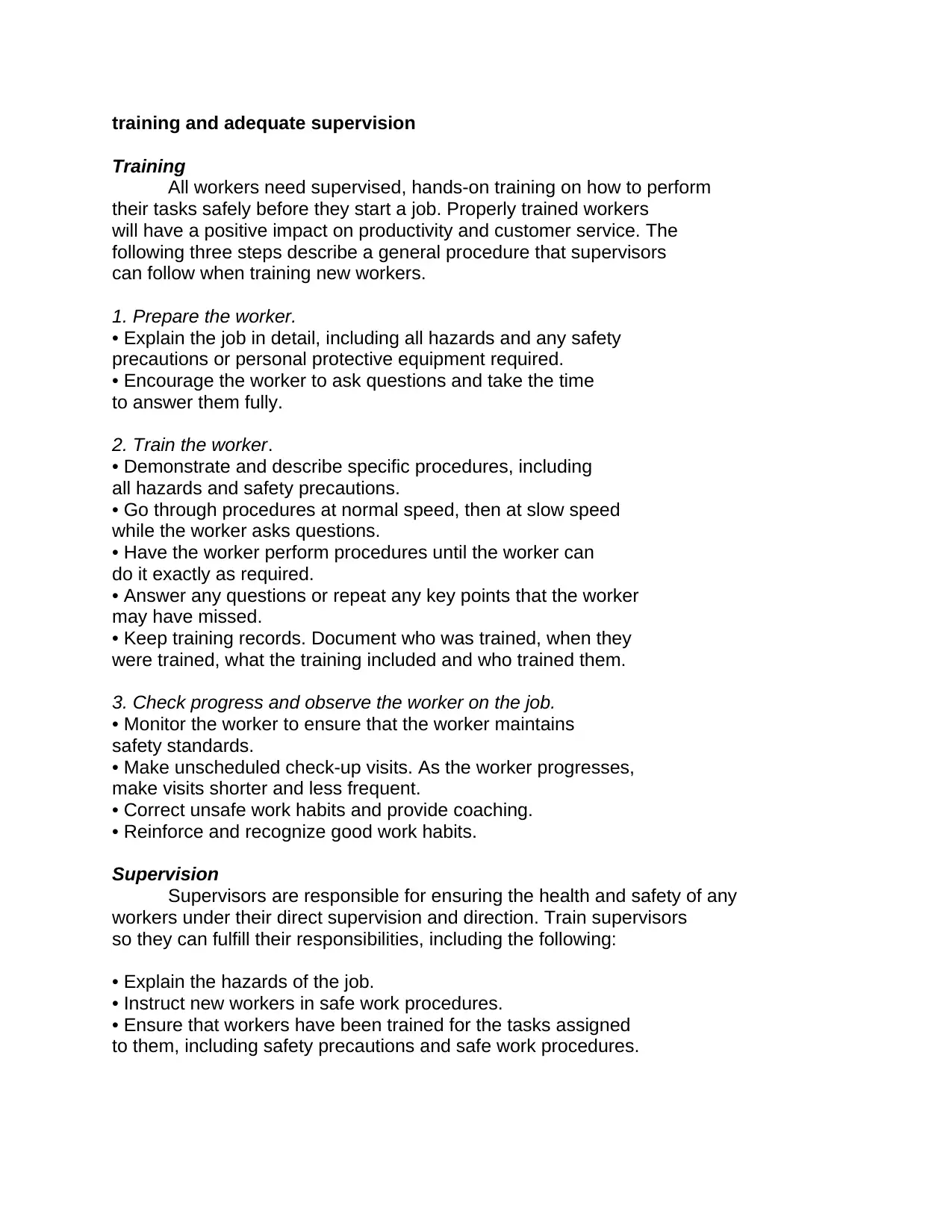
training and adequate supervision
Training
All workers need supervised, hands-on training on how to perform
their tasks safely before they start a job. Properly trained workers
will have a positive impact on productivity and customer service. The
following three steps describe a general procedure that supervisors
can follow when training new workers.
1. Prepare the worker.
• Explain the job in detail, including all hazards and any safety
precautions or personal protective equipment required.
• Encourage the worker to ask questions and take the time
to answer them fully.
2. Train the worker.
• Demonstrate and describe specific procedures, including
all hazards and safety precautions.
• Go through procedures at normal speed, then at slow speed
while the worker asks questions.
• Have the worker perform procedures until the worker can
do it exactly as required.
• Answer any questions or repeat any key points that the worker
may have missed.
• Keep training records. Document who was trained, when they
were trained, what the training included and who trained them.
3. Check progress and observe the worker on the job.
• Monitor the worker to ensure that the worker maintains
safety standards.
• Make unscheduled check-up visits. As the worker progresses,
make visits shorter and less frequent.
• Correct unsafe work habits and provide coaching.
• Reinforce and recognize good work habits.
Supervision
Supervisors are responsible for ensuring the health and safety of any
workers under their direct supervision and direction. Train supervisors
so they can fulfill their responsibilities, including the following:
• Explain the hazards of the job.
• Instruct new workers in safe work procedures.
• Ensure that workers have been trained for the tasks assigned
to them, including safety precautions and safe work procedures.
Training
All workers need supervised, hands-on training on how to perform
their tasks safely before they start a job. Properly trained workers
will have a positive impact on productivity and customer service. The
following three steps describe a general procedure that supervisors
can follow when training new workers.
1. Prepare the worker.
• Explain the job in detail, including all hazards and any safety
precautions or personal protective equipment required.
• Encourage the worker to ask questions and take the time
to answer them fully.
2. Train the worker.
• Demonstrate and describe specific procedures, including
all hazards and safety precautions.
• Go through procedures at normal speed, then at slow speed
while the worker asks questions.
• Have the worker perform procedures until the worker can
do it exactly as required.
• Answer any questions or repeat any key points that the worker
may have missed.
• Keep training records. Document who was trained, when they
were trained, what the training included and who trained them.
3. Check progress and observe the worker on the job.
• Monitor the worker to ensure that the worker maintains
safety standards.
• Make unscheduled check-up visits. As the worker progresses,
make visits shorter and less frequent.
• Correct unsafe work habits and provide coaching.
• Reinforce and recognize good work habits.
Supervision
Supervisors are responsible for ensuring the health and safety of any
workers under their direct supervision and direction. Train supervisors
so they can fulfill their responsibilities, including the following:
• Explain the hazards of the job.
• Instruct new workers in safe work procedures.
• Ensure that workers have been trained for the tasks assigned
to them, including safety precautions and safe work procedures.
Paraphrase This Document
Need a fresh take? Get an instant paraphrase of this document with our AI Paraphraser
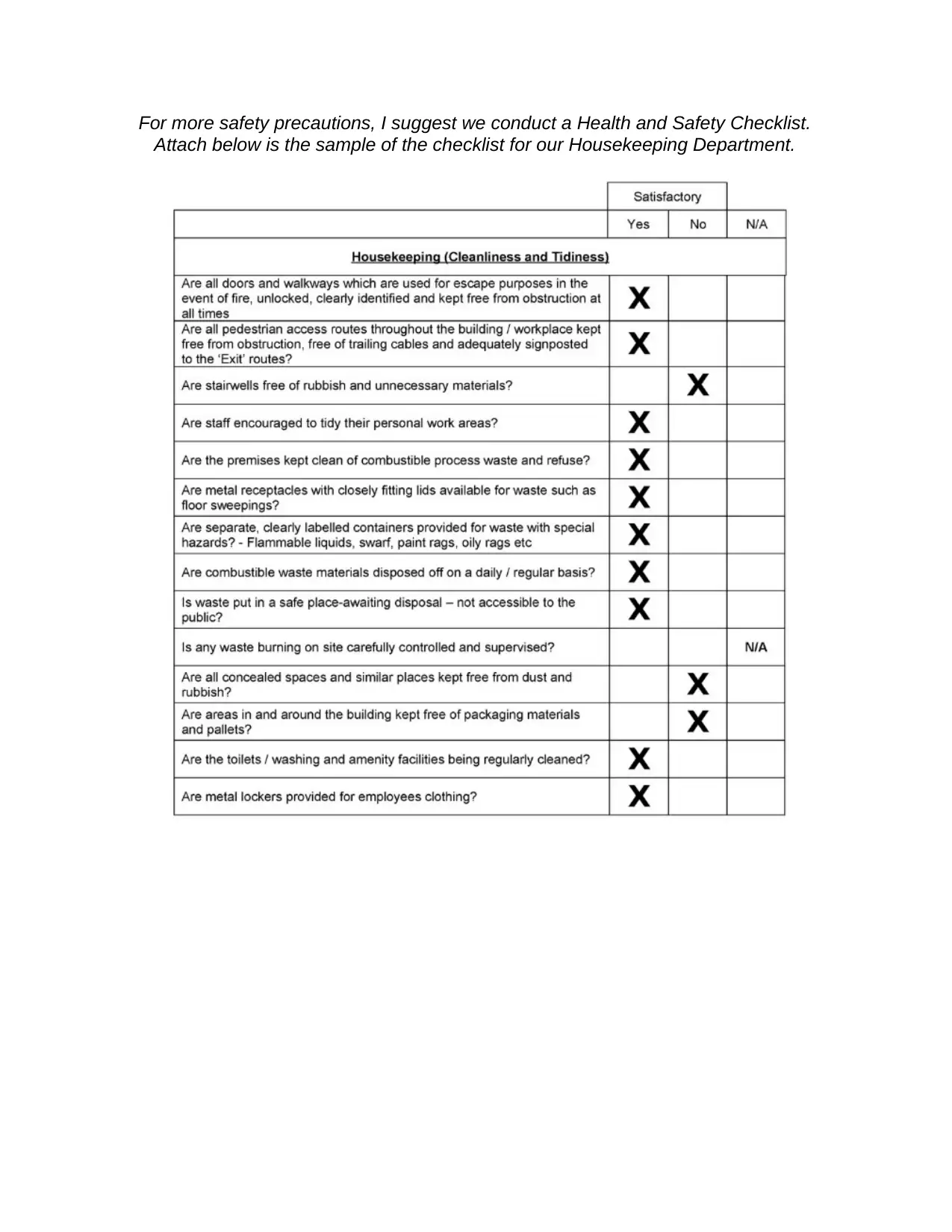
For more safety precautions, I suggest we conduct a Health and Safety Checklist.
Attach below is the sample of the checklist for our Housekeeping Department.
Attach below is the sample of the checklist for our Housekeeping Department.
1 out of 8
Your All-in-One AI-Powered Toolkit for Academic Success.
+13062052269
info@desklib.com
Available 24*7 on WhatsApp / Email
![[object Object]](/_next/static/media/star-bottom.7253800d.svg)
Unlock your academic potential
Copyright © 2020–2025 A2Z Services. All Rights Reserved. Developed and managed by ZUCOL.